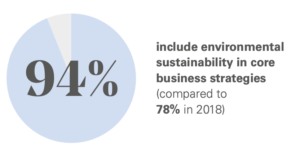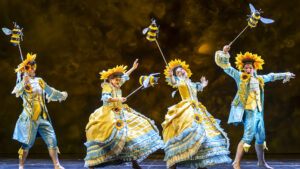- Posted on February 14th, 2024
Culture as Catalyst for Deep Rooted Change
As Arts Council England (ACE) publish their latest Environmental Programme Annual report, Julie’s Bicycle’s ACE Project Lead Vicky Sword-Daniels reflects on cultural organisations’ achievements, and how their creative climate action is helping us into a brighter future.

Culture has always mediated our deep-rooted relationships with the natural world and with each other, for good and for ill. And now cultural expression is orientating towards the imagination, ideas that question unequal overconsumption and its devastating consequences. This means thinking carefully, deeply, and creatively about the world we want, founded on values that centre care, justice, and shared endeavour.
Imaginative and inspiring creative responses to the climate, nature and justice crisis are happening all across the arts and culture sector – from visual arts to museums, theatres to libraries, music and dance to combined arts – and through our collaboration with Arts Council England, we at JB have been privileged to witness more than a decade of creative climate action. We’ve seen hundreds of organisations, large and small, commit to understanding, acting and improving the sustainability of their operations, their creative programming and influencing others.

Solid Foundations

In 2012, the Arts Council pioneered a cultural policy that embedded environmental sustainability as part of National Portfolio Organisations’ (NPO) reporting requirements. Collective reporting across the culture sector year-on-year shows that organisations are getting the basics right – placing the environment at the core of their organisational vision and mission, recognised in values, embedded in policies, and in action plans that use their environmental impact data to inform where to focus and prioritise efforts. The combined response from across the portfolio has a strong foundation, with new ideas, new knowledge and new networks.

The latest 2022/23 report celebrates what organisations have been doing. People are engaging schools, local communities, visitors and audiences with creativity on intersections between climate and justice, health, waste and material reuse, traditional practices and nature restoration. Inspiring examples are proliferating, from every region across the country, and are both specific and diverse.
Over a five-year period, through the efforts of hundreds of NPOs, cultural organisations have achieved a 20% reduction in their energy usage. Even more broadly, the average emissions of reporting NPOs are now 50% lower than a decade ago. These are great achievements, but far more needs to be done far faster to meet this moment.
Last year was the hottest on record, and the first time we surpassed 1.5 degrees of warming for a full year. The challenges we are facing today are all interconnected – organisations have faced spending cuts, the wake of a pandemic, cost of living and energy crises, weather events such as flooding, and more. What they have managed against this backdrop, with thin resources, should be recognised. This has been achieved with a huge amount of commitment and heart. It proves a lot can be done with a little, and we need to do a lot more.
The collective actions of arts and culture organisations clearly convey commitment, and potential as change makers, culture-shifters, inspiration-givers and collaborators. And they can be so much more… We need to build on this as fast, and as well, and as craftily and carefully as we can. We need to pilot, experiment, draw wisdom from the collective, to learn from and share our failures and our successes, to witness and celebrate others’ achievements – and to build a collective sense of possibility.
 Masque of Might, Opera North. Photo © James Glossope
Masque of Might, Opera North. Photo © James Glossope
Culture on the global stage – what’s next?
The groundswell of creative responses evidences and demonstrates the unique power and position of the culture sector to engage, inform, challenge our perceptions and create innovative solutions that centre care, regenerative approaches, collaboration and empathy. But what this movement needs now more than ever is for commitment to be matched with the support, funding and frameworks that can embed the arts and culture at the core of climate policy, to catalyse and scale creative values and innovative solutions that can create a step-change towards the future we need.
We have been drawing on this decade of evidence and achievements of so many hundreds of cultural organisations, and collaborating with global networks and partners, to make sure culture’s potential is recognised – this has taken us to the climate COP and beyond. Now we are leading the campaign for a Global Call to put culture at the heart of climate action.
This is a journey built on the generosity of hundreds of cultural voices, taking responsibility for their impacts, using their influence and forging new ideas for a sustainable future. The path for culture and the role that it can play in the global climate nature and justice crisis is expanding.
With a little bit of heft, the future can be bright because it is being forged, not on quick fixes or tech solutions, but through care, creativity and collaboration.
Read the 2022/2023 Arts Council Environmental Responsibility Report

